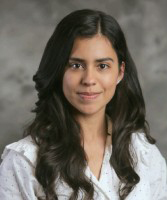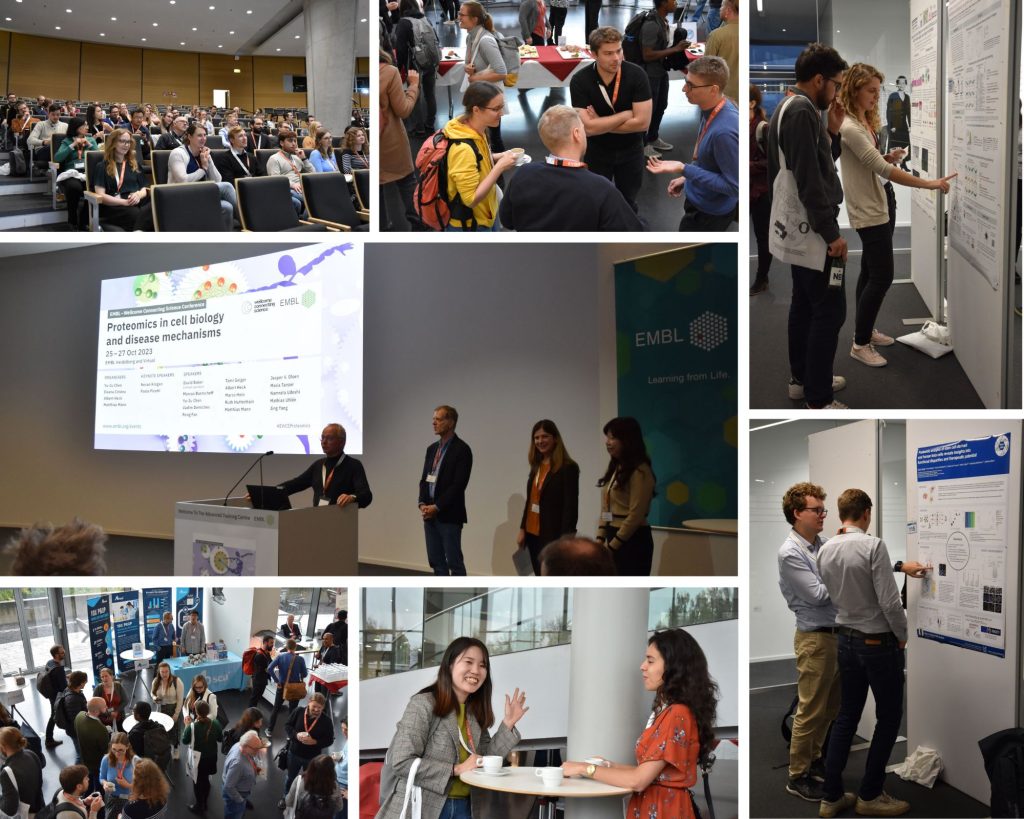The highlights of ‘Proteomics in cell biology and disease mechanisms’
Written by event reporter Daniela Castillo Perez
The 2023 edition of the EMBL–Wellcome Connecting Science Conference ‘Proteomics in cell biology and disease mechanisms’ was highly organised to cover a broad range of topics. The event was composed by a very dynamic program including two keynote lectures, talks by outstanding early career researchers, flash talks, and poster presentations. Out of the many reasons to applaud the conference organizers, I would like to highlight and expand on two of them: the social aspect of the conference and the academic content of this event.

First, as an event reporter, I can confirm that this event was an amazing opportunity to share science in a friendly manner. The scientific environment of collaboration among participants was remarkably noticed after each lecture, when many questions, feedback, and networking opportunities flourished. Spaces for interaction among participants e.g., lunch with speakers and time slots reserved for the poster presentations let me witness that scientists and their scientific projects can thrive when they are nurtured by insights from other scientists with different backgrounds. It was my first time attending a conference at EMBL, and I cannot wait to attend the next conference on my list!
The second aspect regarding the academic content, I can say that the organizers did an outstanding job by finely sectioning the conference into five sessions covering different approaches involving proteomics in cell biology research and disease mechanisms.
The first session covered lectures on cellular communication and interactions. The presentation by Maria Tanzer, from Walter and Eliza Hall Institute, Australia, highlighted the application of a systems level proteomic analysis of macrophages in efferocytosis. The identification of dynamic modifications on receptors, besides other signalling components, has been helpful to elucidate pathways not previously linked to macrophage efferocytosis. However, further functional analysis will be required to interpret the regulation of all these factors on efferocytosis and macrophages.
In addition, the lecture by Kelly Stecker, from Utrecht University, The Netherlands, showed how to quantify short-term protein and phosphorylation dynamics between and within physically interacting cells by Hybrid quantification of SILAC-barcoded interacting cells (HySic). As clearly stated by the presenter, this is a better tool to understand intercellular communication at a molecular level, allowing to measure signalling dynamics between engaged cells.
The first day was exciting! We experienced the first round of flashtalks, a “minute of fame” in which each poster presenter had the challenge and opportunity to summarize their research and captivate the audience. This interactive approach not only captivated the audience but also was a welcoming invite to other participants to engage with poster presentations and extended networking opportunities.
The second day of the conference started with the session: Proteomics technologies. The remarkable lecture delivered by Jesper Olsen, from University of Copenhagen, Denmark, introduced an ultra-fast scanning narrow window data-independent acquisition (DIA) strategy that can offer significant progress in the field of proteomics as it enables the accurate and rapid protein characterization with high throughput and quantification capabilities.
Another excellent contribution to this session was delivered by the presenter Mikiko Takato, from Kyoto University, Japan. Mikiko and her research team developed PhoxID (photooxidation-driven proximity labeling for protein identification): an entirely chemical, photoactivatable proximity labeling method. PhoxID proposes a better alternative to address the limitation of existing methods that require the fusion of the protein of interest to an exogenous enzyme, being these latter traditional methods, which imply the risk of perturbation on native protein structures, their localisation and function, and thus, resulting in alterations on real potential interactions.
Additionally, Yu-Ju Chen, from Academia Sinica, Taiwan, presented a microfluidics-based chip platform for ultra-sensitive analysis from nanoscale-to-single cell analysis, which serves as an all-in-one station encompassing the entire sample operation for either proteomics or phosphoproteomics workflow. These latter, integrated with data-independent-acquisition (DIA), have demonstrated the resolution of single-cell proteomics and nanoscale-to-single-cell phosphoproteomics for clinical samples, marking progress in miniaturisation of sample preparation for single-cell proteomics aiming to understand complex biological systems. This session was packed with fruitful presentations. The many questions by participants were the best testimony claiming the importance of new emerging technologies in the ever-evolving field of proteomics.
The third session of this day was the perfect opportunity to showcase very trendy topics: single cells and spatial proteomics. To start, Rong Fan, from Yale University, USA, presented how spatially resolved transcriptome sequencing is transforming the study of cell differentiation, tissue development and disease, however, a highlight was that it hasn’t fully included information about the proteins yet. His group developed and further expanded a microfluidic deterministic barcoding in tissue for co-mapping of whole transcriptome and a panel of proteins at the cellular level. This approach is termed spatial co-indexing of epitopes and transcriptomes followed by sequencing (spatial-CITE-seq) for co-mapping of proteins and gene expression, and it has been useful to reveal spatially distinct germinal centre reactions and to investigate cellular heterogeneity. During the same session, Benjamin Furtwängler, from Copenhagen University, Denmark, presented his PhD work on single-cell proteomics and transcriptomics of the human hematopoietic stem and progenitor hierarchy. Specifically, he presented the use of a dynamical modeling of translation to investigate protein expression dynamics during stem cell differentiation.
The last lecture of this session was delivered by Matthias Mann, from Max Planck Institute of Biochemistry, Germany. This presentation highlighted the exponential progress of mass spectrometry (MS)-based proteomics, and the role of AI and machine learning, as amplifiers on such advances. Dr. Mann and his team developed the open-source AlphaPept software suite, which provides a fast data analysis toolbox to the proteomics community. In addition, he presented a novel multidisciplinary workflow called Deep Visual Proteomics (DVP), which brings together high-content microscopy, AI image recognition, and highly sensitive mass spectrometry. This unique combination provides a big picture by connecting visual, spatial, and molecular proteomics data at the level of individual cell types. This contribution will be a crucial step towards more precise and personalized medical treatments. This talk also set the stage for the last day of the conference, which was initiated with the fourth session on Proteomics for Precision Medicine and concluded with the session including topics on Computational Proteomics and Data Analysis.
I wanted to spotlight more lectures and include poster presentations, yet I restrained myself to condense and write about only a few of them. This enriching experience is highly recommended for those who aspire to get into the field of proteomics and jump directly into top-notch research projects, and it is also valuable for those already immersed in the field, seeking to stay abreast of the latest developments. This conference left a memorable impression, characterized by a vibrant community of dedicated and enthusiastic scientists making significant contributions to the field of proteomics from different backgrounds and stages of their careers!

The EMBL–Wellcome Connecting Science Conference ‘Proteomics in cell biology and disease mechanisms’ took place from 25 – 27 October 2023 at EMBL Heidelberg and virtually.
Did you know that you can become an event reporter and receive a conference fee waiver in exchange? Find out how to do that by visiting our Become an event reporter page.